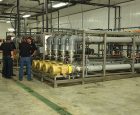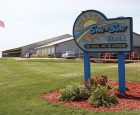
Features
Applications
Dairy
Environment
Environment Protection
Equipment
Manure Application
Profiles
Sustainability
United States
New technology a game changer for Wisconsin dairy
Son-Bow Farms installs AQUA Innovations system to bring down costs of production and keep the Wisconsin dairy in business for years to come.
October 3, 2018 by Diane Mettler
 Son-Bow Farms is comprised of freestall barns, which have a flush flume that runs down the middle of the barns. Prior to the installation of the AQUA Innovations system, the manure and sand-laden manure were flushed into manure tanks and manure storage. Contributed photo
Son-Bow Farms is comprised of freestall barns, which have a flush flume that runs down the middle of the barns. Prior to the installation of the AQUA Innovations system, the manure and sand-laden manure were flushed into manure tanks and manure storage. Contributed photoFour years ago, dairy farmer Jay Richardson and his wife, Kristi – owners of Son-Bow Farms in Northwest Wisconsin – sat down for a heart-to-heart to discuss the future of their business.
“My wife and I are first and last generation dairy farmers,” Richardson says. “We started our business in 1994, with milking 50 cows and we just steadily grew it. Today, we’re at around 1,400 cows, with about 35 full-time employees. We were at a crossroads. We had to decide whether we were going to stay in the business and reinvent ourselves to stay competitive, or if we were going to exit the business. Fast-forward, we obviously decided to stay in the business.”
After that meeting, the Richardsons set out to find a way to decrease costs. “The top third of the producers in the dairy industry do about the same thing,” Richardson says. “Everybody does a really good job of getting cows pregnant. They do a good job of getting milk out of cows. They do a really good job of keeping cows in the herd. But the one challenge that still remains – how to handle nutrients in a cost-effective manner. And so, we started to look, and we came upon AQUA Innovations out of Sharon, Wisconsin, and their NuWay Nutrient Concentration System.”
The chance meeting with AQUA Innovations is a story in itself. In his quest to find solutions to decrease their manure-handling costs, Richardson and one of his managers went to a manure management conference in eastern Wisconsin. After going through the food line at the break, Richardson did what he usually does.
“I go find a table that’s empty and I sit down, and then, I wait and see who comes and sits by me.”
And the people that came to sit by him were Mike Gries from Foxland Harvestore, also Wisconsin-based, and, on the other side of the table, sat Tom Hrinowich, the president of AQUA Innovations at the time.
“We started talking and the rest, as they say, is history.”
From that conversation four years ago, Son-Bow Farms became the first dairy to merge the cleaning and recycling of bedding with converting manure into distilled water and nutrient rich fertilizer.
Other systems the Richardsons had previously looked at didn’t meet their needs, which were continuing to bed with sand, but also be able to reuse sand instead of hauling it to the field.
“We really wanted to maintain quality bedding product, but every time we looked at a system that could get our sand clean enough to reuse, it used a lot of water, which just continued to exacerbate our problem by adding more water to a system that already had too much water in it,” Richardson says.
The AQUA Innovation’s technology was an ideal choice because it used ultra-filtration (UF) and reverse osmosis (RO) and did not use any polymers, which was very important to Son-Bow.
“It was also flexible enough that it can be on the backend,” he adds. “It can be used with or without a digester, and we don’t have a manure digester.”
The dairy is comprised of freestall barns, which have a flush flume that runs down the middle of the barns. Prior to the installation of the AQUA Innovations and DariTech equipment, the manure and sand-laden manure were flushed into manure tanks and manure storage.
As part of the project, the Richardsons built two buildings – one for solids and one for water.
“The solids building is 80 by 200. It holds all of the solids equipment, where the manure and sand-laden manure is flumed from our freestall barns,” Richardson says. “It also holds our cleaned sand and re-bedding equipment. The second building is the water building, houses all of the AQUA Innovations equipment.”
Mike Gries from Foxland Harvestore, who was at the initial table meeting, was contracted by the Richardsons to help design both the pre-treatment system, to extract the manure solids out from the barns, and the system for cleaning the sand.
The design used all DariTech equipment. Richardson says the larger solids are extracted, ahead of running their flume. This way the water is cleaner and does a much better job of cleaning the sand in pre-treatment.
“With this method, we’re getting excellent quality recycled sand, because it was pre-cleaned up front,” he says.
In the solids building, the sand is recycled by running it through a DariTech One Shot bedding recovery system that lifts, rinses and stacks the sand as well as a DTX and a three-roll press to extract as much water from the solids as possible.
“With our new system, [in the water building] we’re able to concentrate those nutrients and discharge water. It takes a lot less storage space. We used to have about six months worth of storage. Now, we’re going to have closer to 24 months worth of storage, without adding additional storage space.”
While the sand is being cleaned, Son-Bow simultaneously takes all of the larger extracted solids and runs them through a composter.
“We’re using a DariTech centrifuge to get us down to, approximately, 1 to 1.2 percent total suspended solids,” Richardson says. “Off of the centrifuge then, we’re sending that water over to the water building. It first goes through the ultra filtration (UF,) and then, the reverse osmosis (RO,) which results in two environmentally safe byproducts: distilled water and nutrient-rich compost.”
The byproduct that comes out goes into a common auger, which feeds two DariTech Bedding Master machines. However, Richardson states, “we are not using the compost for bedding. We’re using those to speed up the natural compost process.
“In the compost process we’re killing the bad bugs, and we’re kick-starting and growing all of the good bugs or bacteria for helping the soil,” Richardson says. “There is a huge movement in agriculture in biologics. And so, instead of feeding the corn crop the nitrogen, phosphorus and potassium (NPK) chemistry, we’re feeding the bugs and letting the bugs feed the corn crop the NPK.
Richardson adds: “We still have to feed the crop some NPK, but it is significantly reduced.”
The resulting compost Richardson would liken to a soil inoculant.
“And we have a market for selling it. Not in the retail market, but 90 percent is sold to other farmers.”
What has been exciting for Son-Bow, are the synergies and benefits that the AQUA Innovations system has created. For example, by just reducing the amount of the volume that Son-Bow has to handle, the dairy now has the freedom to choose those times or days of the year when conditions are most conducive for fertilization.
“In the past, we get done chopping corn in the fall, and it’s like, ‘Okay. It’s a race to freeze up,’” Richardson says. “And you got a gun to your head and you have got to go every day.”
The AQUA Innovations NuWay nutrient concentration system is also an all-mechanical separation process. It reclaims, as Richardson mentioned earlier, more than 50 percent of manure as distilled water without the use of chemicals. The other by-product of the process is the organic super nutrient fertilizer with virtually no phosphorus or pathogens.
“The NuWay system is environmentally compliant, customizable to any dairy operation and provides 24/7 remote monitoring and support from AQUA Innovations,” says Chris Lenzendorf, president of AQUA Innovations.
“I also appreciate the scalability,” Richardson says. “You can scale the system from as small a herd as, I believe, 600 head. Our system is currently sized up for about 2,000 cows. But the real beauty of the system is that the Aqua Innovations UF takes out about 95 percent of the phosphorous. We have a highly concentrated NP&K coming off the UF. And then, we have a highly concentrated N with a little, tiny bit of P, and lots of K, off Aqua Innovations RO. We keep those products separate in our two-stage lagoon and can easily give our individual fields the mix they require.”
The nutrient-rich by-product gives Richardson a 4 to 1 concentration, which means Richardson can haul one truckload instead of four.
“It costs the same amount of money to haul a semi-load of this product up and down the road, but since the concentration is four times higher, we’ve cut our per-acre costs by three quarters.
“With recycling the sand,” Richardson continues, “We’re saving even more.”
And, with all these benefits, Son-Bow expects to decrease its cost of milk production by approximately $1.80 per 100-weight.
“In other words, we expect the system to completely pay for itself in about five or six years.”
As far as milk quality, Richardsons have been pleased.
“We’re still running about an 80,000 cell-count. We’ve seen that creep up just a little bit, but it’s not quite a fair test because we’re in the summer months now, and we typically go up in summer. We were at about a 60,000 cell-count prior to that in March on virgin sand. However, we’re not treating any more cows currently and that’s a good sign.”
The system has only been operational a few months and Richardsons is still adjusting it, but so far everyone is extremely satisfied with the results. It looks like it’s going to allow the couple to continue to maintain a cost-effective dairy in a competitive market.

